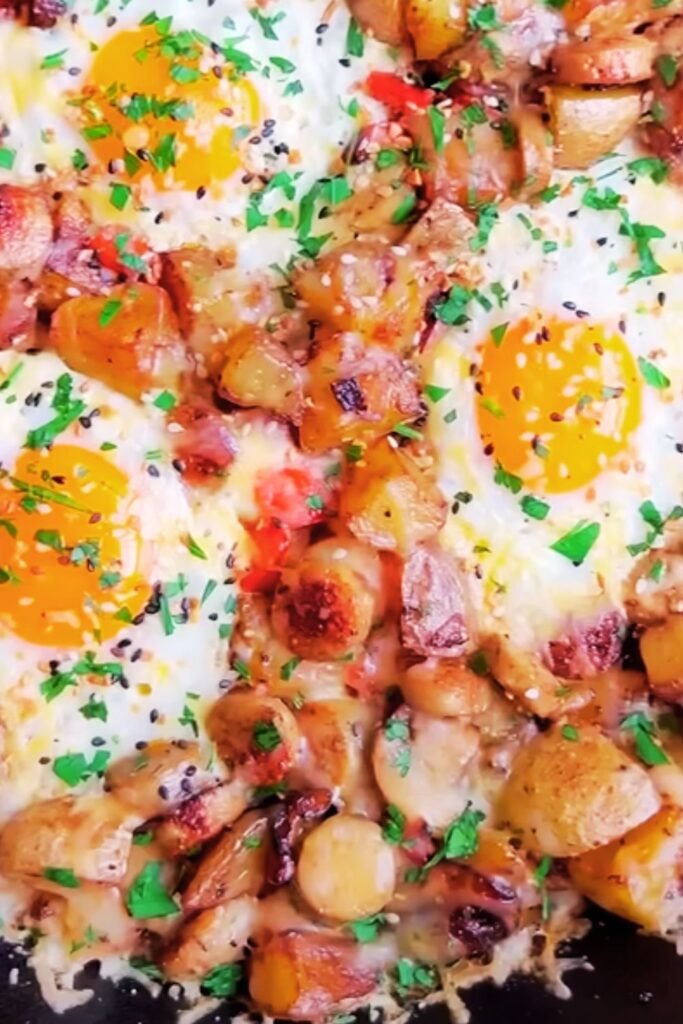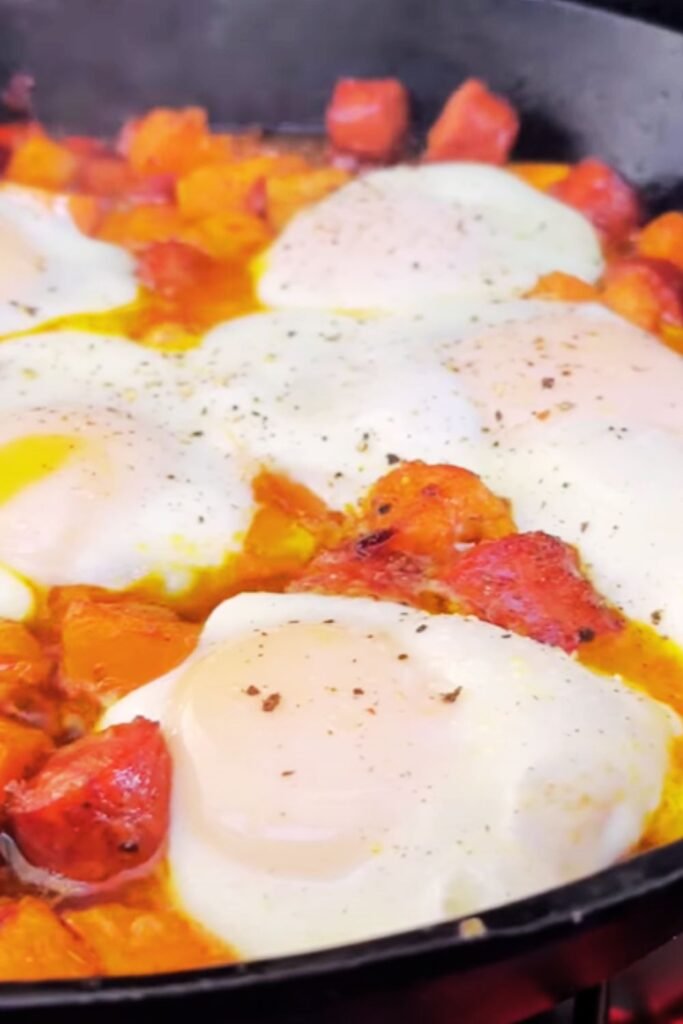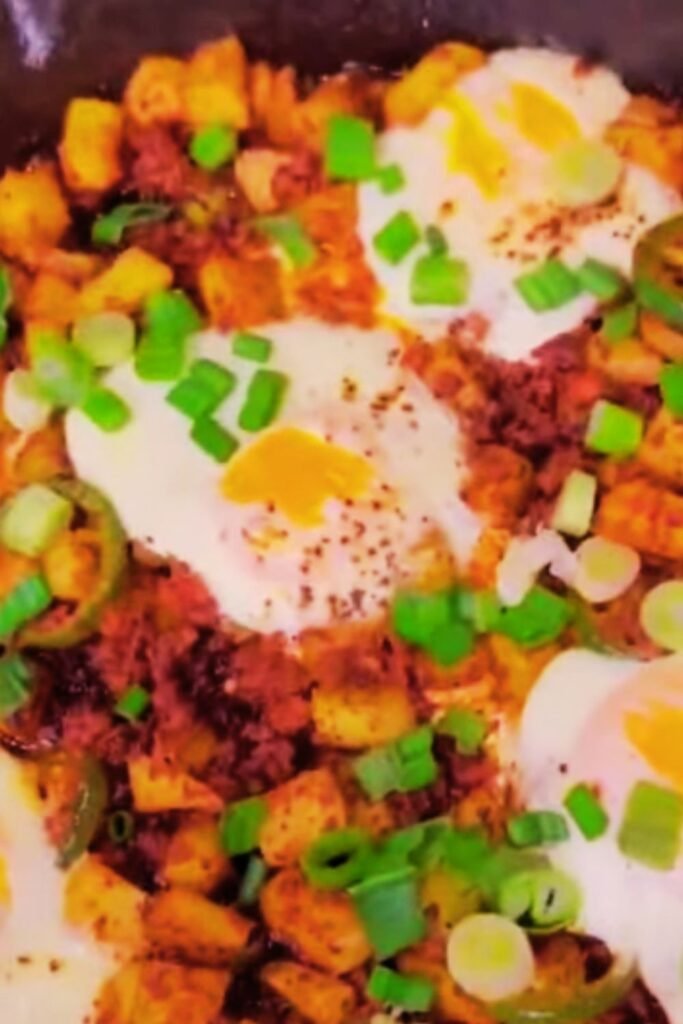There’s something magical about the combination of spicy chorizo, creamy sweet potatoes, and perfectly cooked eggs all nestled together in one gorgeous skillet. I’ve been perfecting this recipe for months, and let me tell you, it’s become my go-to whenever I want to impress guests or treat myself to something special on a lazy weekend morning.
This isn’t just another breakfast recipe – it’s a complete meal that brings together bold flavors, satisfying textures, and vibrant colors that’ll make your kitchen smell absolutely incredible. The smoky paprika from the chorizo mingles beautifully with the natural sweetness of the potatoes, while the eggs tie everything together with their rich, creamy yolks.
What Makes This Recipe So Special
I’ve discovered that the secret to an exceptional chorizo and sweet potato skillet lies in the layering of flavors and the timing of each ingredient. Unlike many breakfast dishes that can feel heavy or one-dimensional, this recipe creates a perfect balance of protein, vegetables, and healthy fats that’ll keep you satisfied for hours.
The beauty of this dish extends beyond just taste. It’s incredibly versatile – I’ve served it for brunch parties, quick weeknight dinners, and even as a late-night comfort food when I’m craving something hearty. The presentation is stunning too, with the golden egg yolks creating a natural sauce that brings all the ingredients together.
Essential Ingredients and Their Roles
Understanding each ingredient’s contribution helps you make the perfect skillet every time. Here’s what you’ll need and why each component matters:
Chorizo Selection : Choose Spanish chorizo for a firmer texture and smokier flavor, or Mexican chorizo for a softer, more intensely spiced result. I prefer using about 8 ounces for a 12-inch skillet, which provides the perfect meat-to-vegetable ratio.
Sweet Potato Varieties : Orange-fleshed sweet potatoes work best because they hold their shape well while developing a creamy interior. I recommend using about 2 medium sweet potatoes, peeled and diced into ¾-inch cubes.
Egg Quality : Fresh, free-range eggs make a noticeable difference in both flavor and appearance. The yolks should be bright orange and firm, creating that perfect runny center we’re after.
Supporting Cast : Yellow onions add sweetness and depth, while bell peppers contribute crunch and color. Fresh herbs like cilantro or parsley brighten the entire dish.
Detailed Cooking Instructions
Step 1: Preparing Your Ingredients
Start by prepping everything before you begin cooking – this recipe moves quickly once you get started. Dice your sweet potatoes into uniform pieces to ensure even cooking. I’ve learned that slightly smaller pieces work better than large chunks because they cook through more evenly.
Remove the chorizo from its casing if using Mexican chorizo, or slice Spanish chorizo into ¼-inch rounds. Crack your eggs into individual small bowls – this makes it much easier to add them to the skillet without breaking the yolks.
Step 2: Building the Flavor Base
Heat your cast-iron skillet over medium heat. I always use cast iron for this recipe because it retains heat beautifully and creates those amazing crispy edges on the potatoes. Add the chorizo first – it’ll release its oils and create the fat you need for cooking the vegetables.
Cook the chorizo for about 3-4 minutes, stirring occasionally until it starts to crisp up and release its rendered fat. The key here is patience – you want to develop that deep, caramelized flavor that makes the entire dish sing.

Step 3: Adding the Sweet Potatoes
Add your diced sweet potatoes to the skillet with the chorizo. This is where the magic starts happening – the sweet potatoes will absorb some of that delicious chorizo fat while developing their own caramelized exterior.
Season with salt, pepper, and a pinch of smoked paprika. Cook for about 8-10 minutes, stirring every few minutes to ensure even browning. The sweet potatoes should be tender when pierced with a fork but still hold their shape.
Step 4: Incorporating the Aromatics
Add your diced onions and bell peppers to the skillet. These vegetables cook more quickly than the sweet potatoes, so they go in later. Cook for another 3-4 minutes until the onions become translucent and the peppers start to soften.
Create small wells in the mixture for your eggs. I use the back of a spoon to make these indentations – they help keep the eggs in place and prevent them from spreading too much across the skillet.
Step 5: The Perfect Egg Finish
Carefully crack each egg into its designated well. Reduce the heat to medium-low and cover the skillet with a lid. This creates a gentle steam that cooks the egg whites while keeping the yolks runny.
Cook for about 4-6 minutes, depending on how you like your eggs. I prefer slightly runny yolks that create a natural sauce when broken, but you can cook them longer for firmer yolks if that’s your preference.
Nutritional Profile and Health Benefits
This skillet provides an impressive nutritional profile that makes it perfect for active lifestyles. Here’s a detailed breakdown of what you’re getting in each serving:
| Nutrient | Amount per Serving | % Daily Value | Health Benefits |
|---|---|---|---|
| Calories | 445 | 22% | Sustained energy release |
| Protein | 28g | 56% | Muscle maintenance and satiety |
| Carbohydrates | 24g | 8% | Complex carbs for steady energy |
| Fiber | 4.5g | 18% | Digestive health support |
| Fat | 28g | 43% | Healthy fats for nutrient absorption |
| Vitamin A | 15,680 IU | 314% | Eye health and immune function |
| Vitamin C | 28mg | 47% | Antioxidant protection |
| Iron | 3.2mg | 18% | Oxygen transport and energy |
| Potassium | 756mg | 22% | Heart health and blood pressure |
The sweet potatoes are nutritional powerhouses, loaded with beta-carotene, which your body converts to vitamin A. They also provide complex carbohydrates that give you sustained energy without the crash you might experience from processed breakfast foods.
Chorizo contributes high-quality protein and essential amino acids, while the eggs provide additional protein plus choline for brain health. The combination creates a meal that’s both satisfying and nutritionally complete.

Flavor Variations and Customization Options
One of the things I love most about this recipe is how easily it adapts to different tastes and dietary preferences. Here are some variations I’ve experimented with:
Mediterranean Style: Replace chorizo with Italian sausage, add sun-dried tomatoes, olives, and finish with crumbled feta cheese. The briny olives create an interesting contrast with the sweet potatoes.
Vegetarian Version: Substitute the chorizo with seasoned black beans or crumbled tempeh. Add extra smoked paprika and a dash of liquid smoke to maintain that smoky depth.
Spicy Kick: Include diced jalapeños or serrano peppers with the onions, and finish with a sprinkle of cayenne pepper or hot sauce. I sometimes add a pinch of chipotle powder for smokiness.
Herb-Forward: Fresh thyme, rosemary, or sage work beautifully with sweet potatoes. Add them during the last few minutes of cooking to preserve their bright flavors.
Serving Suggestions and Presentation Tips
Presentation matters, especially when you’re serving this to guests. I’ve learned a few tricks that make this skillet look restaurant-quality:
Serve directly from the cast-iron skillet for rustic charm. The skillet retains heat, keeping everything warm throughout the meal. Place it on a wooden trivet or heat-resistant mat to protect your table.
Garnish with fresh herbs just before serving. Chopped cilantro, parsley, or chives add color and freshness that brightens the entire dish. I also like to add a sprinkle of flaky sea salt on top of the eggs.
Accompany with warm corn tortillas or crusty bread for scooping. The bread helps soak up those delicious egg yolks, and tortillas turn this into an interactive meal where everyone can make their own little breakfast tacos.
Consider adding a dollop of Greek yogurt or sour cream on the side. The cool, tangy dairy provides a nice contrast to the warm, spicy flavors of the skillet.
Storage and Reheating Guidelines
While this dish is best enjoyed fresh, I understand that meal prep is important for busy schedules. Here’s how to store and reheat leftovers effectively:
Refrigerator Storage: Store leftovers in an airtight container for up to 3 days. The eggs will firm up completely when cold, but the flavors continue to meld and develop.
Reheating Methods: I prefer reheating in a covered skillet over medium-low heat, adding a splash of water or broth to prevent sticking. Microwave reheating works but can make the eggs rubbery, so use 30-second intervals and stir gently.
Freezing Considerations: While you can freeze the chorizo and sweet potato mixture, I don’t recommend freezing the eggs as they become grainy when thawed. Cook the base ingredients, freeze them separately, then add fresh eggs when reheating.
Troubleshooting Common Issues
Through trial and error, I’ve encountered and solved several common problems with this recipe:
Soggy Sweet Potatoes: This usually happens when the heat is too low or the skillet is overcrowded. Make sure your skillet is hot enough and don’t stir too frequently – let the potatoes develop that crucial caramelized exterior.
Broken Egg Yolks: Create proper wells in the mixture and crack eggs into a small bowl first, then gently slide them into the skillet. Room temperature eggs are less likely to break than cold ones.
Uneven Cooking: Cut your sweet potatoes into uniform pieces and don’t overcrowd the pan. If you’re doubling the recipe, use two skillets rather than one large one.
Too Greasy: Some chorizo releases more fat than others. If your skillet seems too oily, drain off excess fat before adding the vegetables.

The Science Behind Perfect Timing
Understanding the cooking science helps you achieve consistent results every time. Sweet potatoes contain more starch than regular potatoes, which means they need sufficient time to break down and become creamy. The initial high heat creates caramelization on the exterior while the interior slowly becomes tender.
Chorizo fat has a lower smoke point than many cooking oils, so medium heat prevents it from burning while still allowing proper browning. The rendered fat becomes the cooking medium for the vegetables, infusing them with flavor.
Eggs set at different temperatures – whites begin coagulating at 140°F while yolks don’t set until 150°F. The gentle steam method ensures the whites cook through while keeping the yolks creamy.
Advanced Techniques for Flavor Development
After making this recipe dozens of times, I’ve discovered some advanced techniques that elevate the final result:
Deglazing: After cooking the chorizo, add a splash of white wine or chicken broth to deglaze the pan, scraping up any browned bits. This creates additional flavor complexity.
Layered Seasoning: Season at multiple stages rather than just at the end. Salt the sweet potatoes early to help them release moisture and caramelize better.
Temperature Control: Use a thermometer to monitor your skillet temperature. Maintaining 325-350°F ensures even cooking without burning.
Finishing Touches: A squeeze of fresh lime juice just before serving brightens all the flavors and cuts through the richness of the eggs and chorizo.
Questions and Answers
Q: Can I make this recipe in a regular non-stick pan instead of cast iron?
Yes, you can definitely use a non-stick pan, though you’ll miss out on some of the heat retention and browning capabilities that cast iron provides. Make sure your non-stick pan is oven-safe if you want to finish it under the broiler for extra egg browning.
Q: How do I know when the sweet potatoes are perfectly cooked?
The sweet potatoes should be fork-tender but still hold their shape. They’ll have golden-brown edges and give slightly when pressed with the back of a spoon. This usually takes 8-10 minutes over medium heat.
Q: What’s the best way to prevent the eggs from overcooking?
The key is reducing the heat to medium-low once you add the eggs and covering the skillet. Watch for the whites to set around the edges first – that’s your cue that they’re almost done. The residual heat will finish cooking them even after you remove the pan from heat.
Q: Can I prep any of this recipe ahead of time?
Absolutely! You can dice the sweet potatoes and store them in water (to prevent browning) for up to 24 hours. You can also cook the chorizo and sweet potato mixture ahead of time, then reheat and add fresh eggs when ready to serve.
Q: Is there a way to make this recipe dairy-free?
This recipe is naturally dairy-free as written. Just make sure your chorizo doesn’t contain any dairy products – some varieties do include milk proteins as binders.
Q: How many people does this recipe serve?
This recipe serves 4 people as a hearty breakfast or brunch dish, or 2-3 people if you’re serving it as a dinner with sides. The portions are quite generous due to the protein and fiber content.
Q: Can I use different types of eggs?
Duck eggs work wonderfully in this recipe and create an even richer flavor. Quail eggs are adorable but you’ll need about 12 of them to replace 4 chicken eggs. Any fresh eggs will work – the key is using them at room temperature for best results.
Q: What should I do if my chorizo is too salty?
Some chorizo varieties are saltier than others. If yours is particularly salty, rinse it briefly under cold water and pat dry before cooking. You can also balance the saltiness by adding a touch of honey or maple syrup to the sweet potatoes.
This chorizo and sweet potato egg skillet has become one of my most requested recipes, and I hope it brings as much joy to your kitchen as it has to mine. The combination of flavors, textures, and colors makes it perfect for any occasion, whether you’re cooking for yourself or entertaining friends and family.